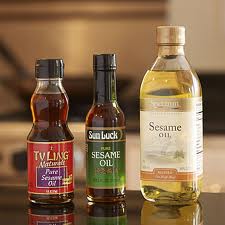
A study finds cooking with a novel ingredient has significant health benefits
People who cook with a blend of sesame and rice bran oils saw a significant drop in blood pressure and improved cholesterol levels, according to new research The researchers found cooking with a combination of these oils in a variety of ways worked nearly as well as a commonly prescribed high blood pressure medication, and that the use of the oil blend with medication yielded even more impressive results.
The 60-day study in New Delhi, India, divided 300 people with mild to moderately high blood pressure into three groups. One group was treated with a commonly used blood pressure lowering medication called a calcium-channel blocker (nifedipine). The second group was given the oil blend and told to use about an ounce each day in their meals. The final group received the calcium channel blocker and the oil blend.
All three groups, with approximately an equal number of men and women, average age of 57, saw drops in their systolic blood pressure. Systolic blood pressure is the top number in a blood pressure reading and measures the force of blood against your artery walls when the heart is pumping. Systolic blood pressure dropped an average of 14 points for those using only the oil blend and 16 points for those taking medication. Those using both saw a 36-point drop. Diastolic blood pressure also dropped significantly: 11 points for those eating the oil, 12 for those on medication and 24 for those using both. Diastolic blood pressure is the bottom number in a blood pressure reading that measures the force of blood against your artery walls when your heart is at rest between beats.
 As for cholesterol, those using the oils saw a 26 percent drop in their LDL (“bad” cholesterol) and a 9.5 percent increase in the HDL (“good” cholesterol), while no changes in cholesterol were observed for the patients who used only the calcium-channel blocker. Those who took the calcium channel blocker and the oils had a 27 percent drop in LDL levels and a 10.9 percent increase in the HDL.
As for cholesterol, those using the oils saw a 26 percent drop in their LDL (“bad” cholesterol) and a 9.5 percent increase in the HDL (“good” cholesterol), while no changes in cholesterol were observed for the patients who used only the calcium-channel blocker. Those who took the calcium channel blocker and the oils had a 27 percent drop in LDL levels and a 10.9 percent increase in the HDL.
Healthier fatty acids and antioxidants, such as sesamin, sesamol, sesamolin and oryzanol, in the oil blends may be responsible for the results, researchers said. These antioxidants, mono and poly unsaturated oils are compounds found in plants and have been linked with lower blood pressure and total cholesterol in earlier studies.
Additional studies are needed to determine if the oil blend is as beneficial as it seems. The combination was made specifically for this study, and there are no plans to market it commercially. Unfortunately, researchers say that blending these oils yourself would not necessarily produce these effects.
People with high blood pressure should not stop taking their medications and should speak with their doctors before trying any product that might change their blood pressure to ensure they’re being properly monitored.
The study was sponsored by the American Heart Association
